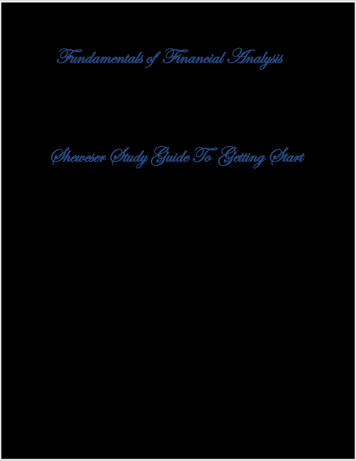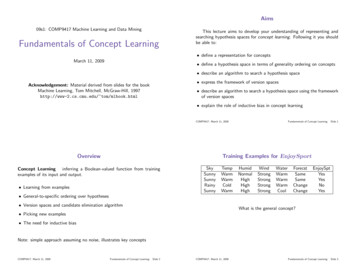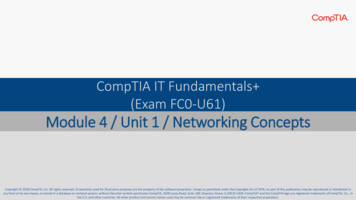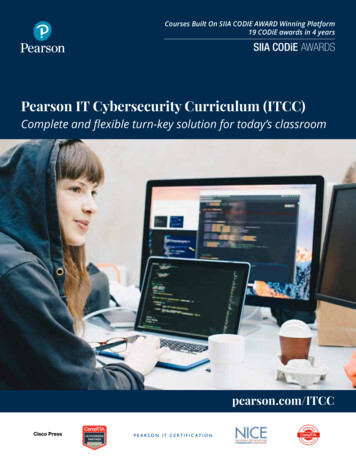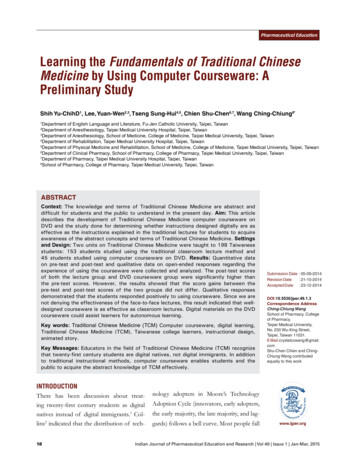
Transcription
Pharmaceutical EducationLearning the Fundamentals of Traditional ChineseMedicine by Using Computer Courseware: APreliminary StudyShih Yu-ChihD1, Lee, Yuan-Wen2,3, Tseng Sung-Hui4,5, Chien Shu-Chen6,7, Wang Ching-Chiung8*Department of English Language and Literature, Fu-Jen Catholic University, Taipei, TaiwanDepartment of Anesthesiology, Taipei Medical University Hospital, Taipei, Taiwan3Department of Anesthesiology, School of Medicine, College of Medicine, Taipei Medical University, Taipei, Taiwan4Department of Rehabilitation, Taipei Medical University Hospital, Taipei, Taiwan5Department of Physical Medicine and Rehabilitation, School of Medicine, College of Medicine, Taipei Medical University, Taipei, Taiwan6Department of Clinical Pharmacy, School of Pharmacy, College of Pharmacy, Taipei Medical University, Taipei, Taiwan7Department of Pharmacy, Taipei Medical University Hospital, Taipei, Taiwan8School of Pharmacy, College of Pharmacy, Taipei Medical University, Taipei, Taiwan12ABSTRACTContext: The knowledge and terms of Traditional Chinese Medicine are abstract anddifficult for students and the public to understand in the present day. Aim: This articledescribes the development of Traditional Chinese Medicine computer courseware onDVD and the study done for determining whether instructions designed digitally are aseffective as the instructions explained in the traditional lectures for students to acquireawareness of the abstract concepts and terms of Traditional Chinese Medicine. Settingsand Design: Two units on Traditional Chinese Medicine were taught to 198 Taiwanesestudents: 153 students studied using the traditional classroom lecture method and45 students studied using computer courseware on DVD. Results: Quantitative dataon pre-test and post-test and qualitative data on open-ended responses regarding theexperience of using the courseware were collected and analyzed. The post-test scoresof both the lecture group and DVD courseware group were significantly higher thanthe pre-test scores. However, the results showed that the score gains between thepre-test and post-test scores of the two groups did not differ. Qualitative responsesdemonstrated that the students responded positively to using courseware. Since we arenot denying the effectiveness of the face-to-face lectures, this result indicated that welldesigned courseware is as effective as classroom lectures. Digital materials on the DVDcourseware could assist learners for autonomous learning.Key words: Traditional Chinese Medicine (TCM) Computer courseware, digital learning,Traditional Chinese Medicine (TCM), Taiwanese college learners, instructional design,animated story.Key Messages: Educators in the field of Traditional Chinese Medicine (TCM) recognizethat twenty-first century students are digital natives, not digital immigrants. In additionto traditional instructional methods, computer courseware enables students and thepublic to acquire the abstract knowledge of TCM effectively.INTRODUCTIONThere has been discussion about treating twenty-first century students as digitalnatives instead of digital immigrants.1 Collins2 indicated that the distribution of tech18 Submission Date : 05-09-2014Revision Date: 21-10-2014Accepted Date: 23-12-2014DOI:10.5530/jper.49.1.3Correspondence AddressChing-Chiung WangSchool of Pharmacy, Collegeof Pharmacy,Taipei Medical University,No. 250 Wu-Xing Street,Taipei, Taiwan 11031.E Mail:crystalccwang@gmail.comShu-Chen Chien and ChingChiung Wang contributedequally to this worknology adopters in Moore’s TechnologyAdoption Cycle (innovators, early adopters,the early majority, the late majority, and laggards) follows a bell curve. Most people fallwww.ijper.orgIndian Journal of Pharmaceutical Education and Research Vol 49 Issue 1 Jan-Mar, 2015
Yu-Chih D. Shih, et al., Learning TCM by Using Computer Coursewareinto the categories of “early majority” and “late majority” (34% and 34%, respectively) and are open to newtechnologies. Therefore, scholars have indicated that themajority of learners today can learn effectively throughdigital learning.The importance of complementary and alternativemedicine is now widely recognized worldwide, even corpora such as the corpus of acupuncture on CQPWebhas been developed to provide standard translation ofbiomedical language.3 The World Health Organization(WHO) has published a formal translation of traditionalmedicine terminology in WHO International Standard Terminologies on Traditional Medicine in the Western Pacific Region.4This further reveals the current significance of alternative medicine.5,6 Traditional Chinese Medicine (TCM) isone of the most commonly used alternative medicineand many researchers have been exploring its effectivefunctions in regulating immune system activity, treatinginfectious diseases, and suppressing tumor growth.7-9Therefore, knowledge of TCM should be included inthe education of medical school. For example, the University of Hong Kong is promoting integrative medicine by developing Chinese medicine programs thattrain students of both Western and Chinese medicine.10In addition, educators have recognized that digitizingChinese medicinal knowledge enables college studentsand the public to acquire effectively an awareness of thebasic and clinical applications of Chinese medicine.11,12These educators have expended effort into developingdigital learning materials.Scholars of educational technology, such as RichardE. Clark,13 have argued that comparing teaching methods that use different media is meaningless. However,TCMinstructors would benefit from determiningwhether digitized TCM instructional materials are aseffective for students to learn the abstract concepts andterms of TCM as traditional classroom instruction. Theconcepts and terms used in TCM are mostly abstract,expressed in classical Chinese,and difficult for studentsand the public to acquire an awareness of in the presentday.Furthermore, terms which appear in Western medicine often have different meanings in the TCM context,requiring teachers and students to carefully avoid misunderstandings.For instance, the meaning of the term“liver” ( “gan” in Mandarin Chinese) in Western medicine is different from its meaning in TCM. In Westernmedicine, the liver is an organ below the diaphragm necessary for digestion. However, “gan”in TCM does notsolely refer to the same organ. Instead, it refers to a system, including the organ liver, blood stream, qi streamand much more. According to WHO, it “stores blood,facilitates the coursing of qi, and is closely related to thefunction of the sinews and eyes”4 (p. 22). Furthermore,it controls the functions of the autonomic nervous system.14 According to Edgar Dale’s Cone of Experience15(p. 143)verbal symbols (i.e., words) are the most abstractof all symbols on the concrete-abstract continuum.Learners can come to a more concrete understanding ofverbal symbols through visual instructional activities, forexample,activities using radios, still pictures, and movies.This is further supported by applying Paivio’s dual-codetheory,15,16 which contends that words (both abstract andconcrete) visualized using pictures are more likely to beremembered by viewers because they are stored usingboth verbal and visual codes rather than just verbal codes.Our literature review found that various studies on digitallearning instruction had been conducted in the area ofconventional medical education.17-19 These studies haveresearched topics including active and reflective questionusage in web-based instruction;17 video clip uses and collaborative learning tools in e-learning settings;20 and theuse of an interactive computer-based training program(ICBT) on dementia in different European countries.21Cook et al.22 performeda meta-analysis on studies ofsimulation-based training for health professions education and identified effective instructional design featuressuch as range of difficulty, repetitive practice, distributedpractice, cognitive interactivity, multiple learning strategies, individualized learning, mastery learning, feedback,longer time for learning, and clinical variation. However,no studies have researched digital learning instruction onTCM. Consequently, this paper explains the developmentof TCM courseware and reports on the performance ofstudents learning through traditional in-class lectures versus coursewareto provide insights into TCM education.Development of the CoursewareIn 2011, computer courseware designed to teach thefundamentals of Chinese medicine using two-dimensional animation was developed with the support of theDepartment of Chinese Medicine and Pharmacy, Ministry of Health and Welfare, Executive Yuan in Taiwan.Ten units on TCM were included: the origin and development of TCM; place of production and harvest of TCM;authentication of TCM; methods of processing andstorage of TCM; characteristics of TCM; denominationand effects of TCM; application of TCM; safety medication of TCM; herb-flavored recipes; and the interactionsof Western Medicine and TCM. Indigenous productsand local herbal markets were also addressed in the unitmaterials (see Figure. 1). The 10 units were distributed tointended users for trial use. After receiving positive feedback from users, the Department of Chinese Medicineand Pharmacy placed the materials on a server accessibleto the public.Indian Journal of Pharmaceutical Education and Research Vol 49 Issue 1 Jan-Mar, 2015 19
Yu-Chih D. Shih, et al., Learning TCM by Using Computer CoursewareFigure 1: Ten courseware unitsThese are instructional computer programs with supporting materials. These materials can be produced on CD-ROM or DVD-ROMs which are portable for learners. Or theycan be placed online on a server for users to access without the limit of time and space. : The contents in the courseware are all in Chinese originally. The English translationsin brackets are added to the figures by the authors.Figure 2: Characters in the digital learning units.20 Indian Journal of Pharmaceutical Education and Research Vol 49 Issue 1 Jan-Mar, 2015
Yu-Chih D. Shih, et al., Learning TCM by Using Computer CoursewareTo assure instructional quality, courseware was designedaccording to the nine events of instruction, which includegaining attention, presenting objectives, recalling prerequisite learning, presenting stimuli, providing guidance,eliciting performance, providing feedback, assessing performance, and enhancing retention and transfer.23 Theseevents are embedded in the contents of the courseware.The contents consist of instructional scenarios usingtext, audio and video, and two-dimensional animations.The details of the digital contents are as followsThe characters and storyThere are five characters that live in Plum Village. Oneis a 60-year-old TCM physician, three are children in thesixth grade, and the last is a 50-year-old lotus farmer.These characters’ names all refer to terms in Chinesemedicine to raise the interest of users and allow themto relate to the subject of study. For examples, first, GeGen (Puerariae radix) is a medical herb in TCM treatingcommon cold with headache and fever,24 and modernresearch has looked at its protections in human retinalpigment epithelial cells.25 Second, Huang Qin (Scutellariabaicalensis Georgi) helps to discard dampness and heat,24and has anti-inflammatory26 and anti-bacterial effects.27Third, Lei Wan (Laccocephalum mylittae) would kill parasites such as taeniasis, oxyuriasis, ancylostomiasis, andascariasis.24,28 Fourth, Lei Gong Gen(Centella asiatica L.)would also help clear heat and harmful materials,29 andcurrent research has indicated that it has anti-oxidativeeffect.30 Lastly, Chang Shan (Dichroa febrifuga) would fightagainst malaria,24 and has anti-inflammatory effect.31As listed from left to right in Figure. 2, the characterscorresponding to these Chinese herbs are: Ge Da Gen,who lives in Plum Village with his family including greatgrandparents; Huang Qin Mei, the prettiest girl in PlumVillage; Lei Wan Wei, a child growing up in the city whohas returned to visit his grandfather, Lei Gong Gen; LeiGong Gen, a Chinese medical physician; and Ge ChangShan, a farmer and father of Ge Da Gen.The story is based on the children’s daily activities inthe 10 units, and as the children raise questions, they areanswered by the TCM physician, Lei Gong Gen. Thestory begins when Lei Wan Wei, a child who lives in thecity, returns to Plum Village to visit his grandfather, LeiGong Gen, who is a TCM physician and owner of anherbal apothecary. Lei Wan Wei feels depressed becausehe is unfamiliar with the people and environs of the village. Lei Gong Gen decides to take Lei Wan Wei to DihuaStreet to purchase Chinese herbs. On the way, they meettwo other children in the village, Huang Qin Mei and GeDa Gen, who join them on their trip. Along the way, LeiGong Gen teaches the children about herbs. The othernine units are similar scenarios designed to contextualizethe focus of the unit.Design featuresThe digital learning units were designed using bright colors, which visually represent the non-mystical and scientific spirit of TCM to older and younger generations inthe present day. The aim is for students and the public toaccept and be willing to learn about Chinese medicine.Although the Chinese herbs taught in the coursewareare mainly harvested and produced in different partsof China, to help students relate to the materials andto eliminate the sense of distance between them andtheir study subject, the story uses places and productsin Taiwan. Herbs mentioned in the story include lián zi(lotus nuts) from Tainan, sān xīng cōng (scallions) fromYilan, and dà zǎo(jujubes) from Miaoli. The charactersalso visit Dihua Street in Taipei, famous for its Chinesemedicine apothecaries.Contents of the unitsIn each unit, there are (a) instructional goals and objectives, (b) interactive instructional contents, (c) a postunit summary, and (d) post-unit assessment items.Structure of the sections50-60minutes per unit)(approximatelyThe animated section in each unit includes each of thefollowing items, not necessarily in the same order, andstudents are able to toggle back and forth between theseitems The opening: Introduction of the characters (3 minutes) Unit description by one of the children (3 minutes) Instructional content: Interactive instruction throughtwo-dimensional animations of interaction between thechildren and the TCM physician (40-50 minutes) Main summary points by one of the children (3 minutes) Unit assessment: 10-30 multiple-choice questions (5minutes) Closing: Introduction of the multimedia team (1minute)Learning assessmentAt the end of each unit, the students were asked asmany as 30 multiple-choice questions. At least 10 questions were intended for each of the three levels: populace (basic), apprentice (intermediate), and master(advanced). Questions were drawn randomly from aIndian Journal of Pharmaceutical Education and Research Vol 49 Issue 1 Jan-Mar, 2015 21
Yu-Chih D. Shih, et al., Learning TCM by Using Computer CoursewareFigure 5: A sample of the assessment area (with the feedback)Figure 3: Three assessment levelsbank of unit test questions. The students could proceedto the next level of assessment items only after passingthe previous level (see Figure. 3 for the icons of the different levels, Figure. 4 for a sample assessment screenwith a question, and Figure. 5 for a sample assessmentscreen with the feedback).The editorial committee consisted of 11 experts, including Chinese medical practitioners and university professors in the areas of TCM and instructional design. Thecommittee reviewed the scripts (characters and storyline), instructional contents, and assessment items ofthe different units. The committee also provided authorized pictures under copyright, photos, and relevantdocuments for the construction of the courseware. Following committee review, the digital production company storyboarded and produced the courseware. Theeditorial committee then trial-tested the courseware andprovided feedback for revisions by the digital production company.METHODSThis study adopted a mixed-method research design,including both quantitative and qualitative methods.The quantitative method enables the researchers to lookat the learners’ academic performances on the unitslearned while the qualitative feedback describes theexperiences and suggestions of the participants.Pilot StudyFigure 4: A sample of the assessment area (with the question)22 A pilot study was performed prior to data collection.Thirty-nine freshman-level college students in the medical university were invited to take part in this pilot studyvoluntarily. College students in all fields were recruitedwith the exception of pharmacy students (because students in the College of Pharmacy would be required toIndian Journal of Pharmaceutical Education and Research Vol 49 Issue 1 Jan-Mar, 2015
Yu-Chih D. Shih, et al., Learning TCM by Using Computer Coursewarestudy TCM in their first year). Participants had no priorknowledge of TCM. Two units of reading materialswere distributed to the reading group (N 12) and computer courseware on DVD was distributed to the DVDlearning group (N 27). This activity was not conductedduring the academic semester and reading materialswere distributed to substitute for classroom lectures.The two units the participants studied were: Applications of TCM, and Interactions of Western Medicineand TCM. Students in both groups were tested beforeand after using the instructional materials. The testsconsisted of multiple-choice questions designed by twoeditorial committee members who teach TCM at theuniversity level. More than 200 questions were designedfor expert review, and 90 questions were selected for thepre-test and post-test of this pilot study (45 questionswith a total score of 45 in each test).Because the sample sizes were small, we used non-parametric tests to compare pre-test and post-test scores.For the students in the reading group, the post-testresults (Mdn 32.00) were significantly higher than thepre-test results (Mdn 26.00), Z -2.54, p .011. Likewise, for the DVD group, the post-test results (Mdn 32.00) were significantly higher than the pretest results(Mdn 22.00), Z -4.30, p .000, meaning that studentsin both groups improved between the two tests. However, the Mann-Whitney U test showed that the differences between the post-test and the pre-test scoresof the two groups (Reading: Mdn 8.00; DVD: Mdn 11.00) did not differ, U 111.50, p .123.This outcomeindicated that neither method was superior.Qualitatively, the students who used the coursewareexpressed concerns that the speed of the narration andthe audio dubbing were slow and monotonous, and suggested the addition of captions. The digital productioncompany implemented these revisions after receivingthis feedback.The study used the same instructional units used in thepilot study: Applications of the TCM, and Interactionsof Western Medication and TCM. The 198 participatingstudents were allowed to choose their mode of learning for these two units and became two groups, thelecture group (N 153) and the DVD group (N 45).The lecture group was taught using the traditional lecture method in the regular class. By contrast, the DVDcourseware group studied the two units on a DVDROM distributed to them individually in a computerlab during class time. Consistency in instruction wasensured because the instructor of the course was alsothe chief editor of the courseware editorial committee.As in the pilot study, both groups of students were pretested and post-tested. Each of these tests consistedof 45 questions selected from the test databank whichundergone expert reviews for their appropriateness andvalidity. The instructor of the course did not handle theanalyses of the test outcomes in order to avoid biases.The DVD group participants were also encouraged togive qualitative feedback regarding the courseware on apiece of paper upon the completion of the two units.Participants and InstrumentsRESULTSThe participants in the actual study were volunteersrecruited from freshmen enrolled in a compulsoryundergraduate herbology course in the College ofPharmacy at a private medical university in NorthernTaiwan. This course addressed the fundamentals ofChinese medicine. All students had to go through theunits in this course, but they could choose whether ornot to be part of this study. Of 200 students enrolled inthe course, 198 students chose to take part in the study.Because they were in their first year of undergraduatestudy, they did not have any prior knowledge of thefield. This means they were at the same starting pointrepresenting the general public who are without anybackground knowledge regarding TCM.The analyzed data provided results quantitatively andqualitatively. The quantitative data were analyzed usingthe Kolmogorov-Smirnov test (K-S test) to verify thenormality of both the pre-tests and post-tests of thelecture group and the DVD group. We found that forthe lecture group, neither pre-test scores (D (121) .177,p .000) nor post-test scores (D (121) .189, p .000)were normally distributed. The DVD group’s pretestscores were normally distributed, D (39) .062, p .20,but post-test scores were not normally distributed, D(39) .148, p .032. As a result, we used non-parametrictests to analyze the scores.For the students in the lecture group, Wilcoxon Signedrank tests showed that there was a statistical significanceData AnalysisData analysis began with the test of normality to see ifthe post-pretest scores and their differences (the gainscores) were normally distributed. If they were normally distributed, then independent t-test and pairedt-test would be conducted to see whether there wereany differences in the improvement between the twogroups and between their pre-test and post-test results.If the data were not normally distributed, then the nonparametric tests Mann-Whitney U test and WilcoxonSigned-rank test would be applied. These statisticalanalyses were performed using SPSS 20 (originally Statistical Package for the Social Sciences, now StatisticalProduct and Service Solutions).Indian Journal of Pharmaceutical Education and Research Vol 49 Issue 1 Jan-Mar, 2015 23
Yu-Chih D. Shih, et al., Learning TCM by Using Computer Coursewareand the post-test results (Mdn 34.00) were higher thanthe pre-test results (Mdn 25.00), Z -7.14, p .000. Notsurprisingly, for the DVD group, the post-test results(Mdn 33.00) were also significantly higher than thepre-test results (Mdn 23.00), Z -5.17, p .000. However, the Mann-Whitney U test showed that the scoregains of the post-test and the pre-test scores of the twogroups (Lecture: Mdn 9.00; DVD: Mdn 10.00) didnot differ, U 2124.00, p .349.The students in the DVD group qualitatively sharedtheir experiences of using courseware, and some indicated advantages. One student wrote, “The animationand pictures in the DVD courseware enhance my learning and memory of the Chinese herbs,” and noted, “Ican repeat and review the contents in the coursewareas long as I want.” Other students suggested includinghandouts to accompany the courseware, and increasingthe number of types of herbs and the assessment items.Participants also noted that the courseware could promote knowledge of TCM and raise the public’s interestif made accessible on the Internet, because of its livelydesigns and simplified explanations of the complicatedsubject matter. This positive feedback was implementedand the instructional contents are currently online andavailable to the public both on the websites of theDepartment of Chinese Medicine and Pharmacy, Ministry of Health and Welfare, Taiwan(see here for a lass/detail.do?id 565775397749476&gaid 10),as well ason the Open Courseware website of the university inTaipei where the study was conducted (for online andmobile learning, see here: http://ocw2.tmu.edu.tw/podcasts/8?locale zh tw).DISCUSSION AND CONCLUSIONThe study results showed that students taught usingboth traditional lecture methods and courseware demonstrated improved test scores after instruction. Thedifference between the post-and-pre-test scores (i.e.,score gains) of the lecture group and the coursewaregroup was statistically insignificant. As Gupta and Saks32indicated, classroom lectures have multiple advantagesand we do not seek to deny the effectiveness of liveclassroom teaching. Our result indicates that welldesigned courseware can be as effective as lectures toinstruct students.Designers of computer courseware should considerlearning theories appropriate for student needs. Thecourseware used in this study presents instructionalcontents and interactive components according to wellknown instructional designer Gagné’s nine events ofinstruction,23 starting with an interesting story to raise24 the student’s attention, providing learning guidance, tothe stage of enhancing information retention. Becausethe texts of TCM are mostly written in classical Chinese,the lively storyline and two-dimensional visualizationhelp users understand the functions of various herbs.The participants of this study confirmed the effectiveness of the design, reporting that the animated instruction could reinforce their memorization of complicatedherb names and functions. Because Asian people oftentake Chinese medicine and use Chinese herbs in dailycooking as a health strategy,33 such instruction is beneficial not only for pharmaceutical students but also forthe public.Simulated learning and learner control were also components which enabled students to retain knowledgesuccessfully. The DVD courseware included scenariossimulating different situations, such as the use of TCMin the real-life situations, and correct and improperusages of TCM in conjunction with Western medicine.Liao and Chen34 performed a meta-analysis on studiesof simulated computer instruction in Taiwan and foundthat simulated computer instruction has moderatelypositive effects on student academic achievement. Furthermore, the courseware allows learner control, whichmeans the users themselves can choose and decide theirpaths and instruction speed. Computer courseware hasat least three advantages for students: it meets studentlearning needs, it helps students develop a more robustunderstanding, and it reduces the amount of time necessary for accessing information.35 Student ability andlearning speeds are heterogeneous. Learner controlallows students to work at their own pace and repeat theprogram as many times as is necessary to gain sufficientunderstanding. For fast learners, the search and navigation functions save time, enabling them to move on toextended reading.This study has illustrated the development of computercourseware designed to teach the abstract fundamentals of TCM according to educational learning theories.The courseware was created by TCM content experts,learning consultants, and a digital production team.The results reveal that students using courseware andstudents attending traditional classroom lectures bothlearned and improved in their test results. The visualization of abstract concepts, simulated scenarios, and theability of learner control allowed students using courseware to learn as effectively as in the lecture setting.We do not advocate that computer courseware shouldreplace traditional instruction or that it is acceptablefor all students; however, because most students aredigital natives of the twenty-first century and all learners have different learning preferences, computer andweb-based courseware can be adopted either as supple-Indian Journal of Pharmaceutical Education and Research Vol 49 Issue 1 Jan-Mar, 2015
Yu-Chih D. Shih, et al., Learning TCM by Using Computer Coursewaremental to the traditional classroom or for distance orblended teaching. Learners could also make good use ofthis type of materials for autonomous learning. Consequently, future studies could focus on students’ learningstyle preferences and the effects of learning of TCM byusing different instructional methods.11.12.13.14.ACKNOWLEDGEMENTCourseware design and development was supported bythe grant from the Department of Chinese Medicineand Pharmacy, Ministry of Health and Welfare, Executive Yuan, Taiwan, R.O.C. (CCMP100-RD-032). Thestudy was also partially supported by the Research andDevelopment Grant of Fu-Jen Catholic University (No.A0102013). Comments from the anonymous reviewers of this manuscript and the editor of IJPER are alsoacknowledged.SOURCE(S) OF SUPPORTThe development of the DVD courseware used in thisstudy was funded by the Department of Chinese Medicine and Pharmacy, Ministry of Health and Welfare,Executive Yuan, Taiwan, R.O.C.CONFLICT OF ENCES1.2.3.4.5.6.7.8.9.10.Presky M. Digital natives, digital immigrants. On the Horizon [Internet]. 2001;9(5): [cited 2013 July 15]. Available from: t1.pdf.Collins T. What’s wrong right about ebooks for language learning? In: LeungY, Selected Papers from the Twenty-first International Symposium on EnglishTeaching. Taipei,Taiwan: Crane; 2012. p. 34-9.Budgell BS. The language of integrative medicine. J Integr Med. 2013; 11(3):229-32.World Health Organization (WHO). WHO International StandardTerminologies on Traditional Medicine in the Western Pacific Region[Internet]. 2007 [cited 2014 July 14]. Available from: http://www.wpro.who.int/publications/docs/WHOIST 26JUNE FINAL.pdf.Li ZG, Tan JM. Comparative study on WHO Western Pacific Region andWorld Federation of Chinese Medicine Societies international standardterminologies on traditional medicine: Diseases in External Medicine (Part1). J Integr Med. 2013; 11: 67-71.Li ZG. Comparative study on WHO Western
18 Indian Journal of Pharmaceutical Education and Research Vol 49 Issue 1 Jan-Mar, 2015 t µ 9 µ } v www.ijper.org Learning the Fundamentals of Traditional Chinese Medicine by Using Computer Courseware: A Preliminary Study Shih Yu-ChihD 1,Lee Y, uan-Wen 2,3, Tseng Sung-Hui 4,5, Chien Shu-Chen6,7, Wang Ching-Chiung 8* 1Department of English Language and Literature, Fu-Jen Catholic .





